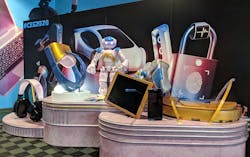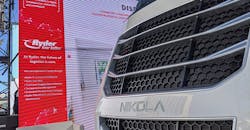CES 2020 Notebook: Transportation tech that caught our eyes
Fleet Owner returned to CES, the annual mega technology show in Las Vegas, in search of potential transportation technology that could help fleets of the future. Here are some news and notes from the more than a million square feet of exhibit space. You can read our coverage of other news out of CES here: (DOT on autonomous vehicles, Peterbilt, Kenworth and Dana, Bosch and ZF, BlackBerry, and more).
Plus.ai to expand autonomous truck tests
Plus.ai announced at CES 2020 it will expand testing of its self-driving trucks to cover all permissible continental states in the U.S. by the end of 2020. This will include closed-course testing and public road testing, with a safety driver and operations specialist onboard to assume manual control if needed.
"We want to build a technology solution that is applicable across different weather, terrains, and driving scenarios,” said Shawn Kerrigan, COO and co-founder of Plus.ai. “Testing our trucks’ readiness means we need to put them through stringent safety tests, on every highway in the country.”
Plus.ai has conducted autonomous truck testing in 17 states: Arizona, California, Colorado, Illinois, Indiana, Kansas, Minnesota, Missouri, Nevada, New Mexico, Ohio, Pennsylvania, South Dakota, Texas, Utah, West Virginia and Wyoming.
"The smart mobility ecosystem we’ve established in Ohio is a premier testing ground for autonomous vehicles," said Patrick Smith, interim executive director of DriveOhio. “Ohio is excited to welcome leading autonomous trucking companies like Plus.ai to test at our state-of-the-art facilities and infrastructure.”
Plus.ai expects that the new testing sites and states will be selected by the spring and implementation will take place through the rest of the year.
Ryder spotlights future of logistics and equipment
Ryder System was among the trucking and logistics companies exhibiting at CES this year. And helping the company catch the eye of attendees was the Nikola Two tractor on display at its outdoor booth that focused on the future of transportation logistics and equipment.
Ryder is showing current and potential leasing customers what is available now — and around the corner — in electric and automated trucks and how they can help increase supply chain efficiency.
Bridgestone shows off airless tires, fleet solutions
Bridgestone made its first appearance at CES, and highlighted its mobility solutions that look toward an autonomous future focused on extended mobility, improved safety and increased efficiency.
The company showed off its future airless tires, smart tire technology and its Webfleet Solutions platform. That platform uses data and analytics to move millions of vehicles as efficiently as possible.
"Bridgestone has a nearly 90-year history of using technology and research to develop advanced products, services and solutions for a world in motion," said TJ Higgins, global chief strategic officer of Bridgestone. “As we look to the future, we are combining our core tire expertise with a wide range of digital solutions to deliver connected products and services that promote safe, sustainable mobility and continue contributing to society's advancement."
The company's CES showcase demonstrated how airless tires from Bridgestone combine a tire's tread and wheel into one durable, high-strength structure. This design eliminates the need for tires to be filled and maintained with air.
The company also showed how its digital twin and connected tire technology can be used to generate specific, actionable predictions that can enhance the precision of vehicle safety systems.
Bosch’s virtual visor uses AI to keep eyes in the shade
Bosch unveiled what is called the most drastic improvement to the 100-year-old sun visor.
The Virtual Visor links an LCD panel with a driver or occupant-monitoring camera to track the sun’s casted shadow on the driver’s face.
The system uses artificial intelligence to locate the driver within the image from the driver-facing camera. It also utilizes AI to determine the landmarks on the face — including where the eyes, nose and mouth are located — so it can identify shadows on the face.
The algorithm analyzes the driver’s view, darkening only the section of the display through which light hits the driver’s eyes. The rest of the display remains transparent, no longer obscuring a large section of the driver’s field of vision.
“We discovered early in the development that users adjust their traditional sun visors to always cast a shadow on their own eyes,” said Jason Zink, technical expert for Bosch in North America and one of the co-creators of the Virtual Visor. “This realization was profound in helping simplify the product concept and fuel the design of the technology.”
This use of liquid crystal technology to block a specific light source decreases dangerous sun glare, driver discomfort and accident risk; it also increases driver visibility, comfort and safety.
WEF, Deepen AI create autonomous initiative
The World Economic Forum and Deepen AI unveiled Safety Pool, a global incentive-based brokerage of shared “driving scenarios” and safety data for safe autonomous driving systems.
Aptiv was one of the first publicly announced members of the initiative.
"At Aptiv, we believe that our industry makes progress by sharing, especially when it comes to safety. We are proud to be part of the World Economic Forum's Safety Pool, and we are confident that with continued collaboration, we will deliver the safer and more accessible mobility solutions our communities deserve," said Karl Iagnemma, Aptiv’s president of autonomous mobility.
Safety Pool is gathering a vast and diverse set of driving scenarios and safety data from the major industry players developing ADAS systems and autonomous driving technology, it was announced at CES 2020. Data will be accessible by the members while an incentive scheme ensures the right value is taken and given by every Safety Pool participant, regardless of their size, level of funding, or years of operations.
According to Deepen, WEF and the first publicly announced Safety Pool pioneering members, sharing this data on such a large scale will generate tremendous positive externalities for the whole industry.
Each company developing ADAS systems and autonomous driving technology will have the chance to tap into a massive, common and shared database of driving scenarios on which to train and validate their machine learning models. In this way, the overall safety of operations will drastically increase, accelerating time to deployment.
About the Author
Josh Fisher
Editor-in-Chief
Editor-in-Chief Josh Fisher has been with FleetOwner since 2017. He covers everything from modern fleet management to operational efficiency, artificial intelligence, autonomous trucking, alternative fuels and powertrains, regulations, and emerging transportation technology. Based in Maryland, he writes the Lane Shift Ahead column about the changing North American transportation landscape.



